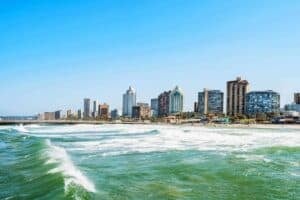There are also signs that the backlog at the container port is easing, with 11 vessels currently at anchorage off the Durban coast awaiting offloading.

State-owned port and logistics operator Transnet last week announced a request for proposals (RFP) for the reconstruction, deepening and lengthening of two berths at Durban Container Terminal’s (DCT) Pier 2 North Quay.
This is part of the R154 billion KwaZulu-Natal (KZN) Ports Master Plan intended to transform the container port into an international container hub. Durban currently ranks among the least efficient in the world, according to a 2022 World Bank study.
ALSO READ: Chaos at ports will cost the country, businesses and consumers
There are also signs that the backlog at the container port is easing, with 11 vessels currently at anchorage off the Durban coast awaiting offloading.
The backlog should reduce to single digits in December as more gantry cranes are brought into service, alongside other efficiency improvements introduced in recent weeks, according to Transnet.
Pier 2 handles roughly 65% of SA’s containerised cargo and is the main link to the country’s hinterland. Transnet says the berth deepening project will help expand the Port of Durban’s throughput from the current 2.7 million TEUs (20-foot equivalent units) to 4.5 million TEUs over the next 10 years.
ALSO READ: Transnet says it can clear Durban port backlog by early 2024
The cost of the five-year berth deepening project is unknown at this stage, and disclosing estimates could potentially skew the outcome of the bidding process.
Crucial step in revitalising port
Bridgette Gasa-Toboti, portfolio director at KZN Logistics Hub for Transnet National Ports Authority (TNPA), told the media on Monday that the berth deepening project had been in the works for more than seven years and is a crucial step in the overall master plan to revitalise the port.
“The increased size of container vessels calling the Port of Durban has necessitated a project of this magnitude, as DCT Pier 2 berths are now operating beyond their original design specification regarding water depth,” said Gasa-Toboti.
Modernisations of Durban’s port infrastructure were needed to address the increase in ship traffic, particularly the ever-increasing size of vessels calling at the port.
ALSO READ: Durban: Exponential time increase at port with delays up to 364 hours in Sept
The berth deepening project is being actioned now because of the need for increased operational capacity, and it will allow other projects in the Ports Master Plan to bear fruit. Transnet says the SA economy is currently sluggish; hence, it is important to prepare now for the eventual recovery in economic growth.
Moshe Motlohi, managing executive for Eastern Region Ports at Transnet, said Durban had lost capacity over time to handle increased ship traffic, particularly as vessels became larger. Whereas Pier 2 could previously handle three ships at a time, this reduced to two as ships became larger.
“With this project, [we] will be able to handle three big ships,” he said.
Pier 2 upgrade
The Pier 2 upgrade aims to improve efficiencies and reduce costs for vessels by deepening berths 203, 204 and 205, including the basin and approach channel, deepening from 12.8 metres to 16.5 metres.
This will remove a crucial bottleneck that prevents vessels requiring a draft of more than 12.2 metres from entering the harbour during low tide.
The berth length will be increased from 914 metres to 1 210 metres to safely accommodate the simultaneous berthing of three Super Post Panamax vessels of 350 metres in length and a draft of 14.5 metres.
Super Post Panamax vessels currently take up two berths on the North Quay, which decreases port container capacity.
The plans call for Durban to be positioned as the country’s premier container and automotive hub, increasing its capacity from 520 000 fully built units (FBUs) per year to one million FBUs. Richards Bay is earmarked to handle dry bulk, including bulk relocated from Durban and liquefied natural gas (LNG).
The SA Navy base on Salisbury Island in Durban is to be relocated to Richards Bay, though it will retain a satellite station at Durban.
ALSO READ: MTBPS: Godongwana tries to tackle municipal debt, electricity and Transnet
The berth-deepening projects will create about 32 730 jobs over five years. The much larger Port Master Plan envisages creating about 570 000 jobs over the next 30 years by deploying R154 billion in capex.
Also planned for Durban are three so-called back-of-port facilities that will assist in decongesting the port.
These are the:
- Durban Logistics Park, an intermodal facility for containers, vehicles, commercial and logistics, with a truck staging area;
- Cato Ridge Intermodal Terminal, a private sector initiative focusing on containers and the automotive sector; and
- Dube Hub, which will integrate with the rail system to evacuate containers to the north of the Durban port.
This article was republished from Moneyweb. Read the original here






